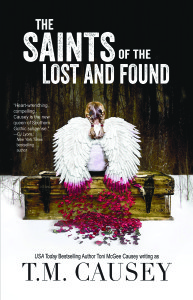by Larry Brooks
When teachers teach, even within the realm of art, the essence of the learning is based on some form of undeniable, unassailable truth. Otherwise, it’s just some guy’s notion of how things are done.
Even finger-painting requires fingers, which are limited in what they can and can’t do. Which creates context for the processes and products of finger-painting.
We teach skydiving and dancing using techniques and proven principles. And even if it’s never mentioned, it is the undeniable and unassailable force of gravity that creates context for the entire proposition.
We teach cooking using techniques and principles and proven recipes. And even if it’s never mentioned, it is an undeniable and unassailable truth – that people don’t like to eat their meat raw unless the words sushi or tartare are within visual range – that creates context for the entire proposition.
I could go on. If you’ve read my writing books you know I’m fond of analogies (and of going on), often to the extent I receive nasty personal notes from readers who, well, don’t appreciate them, or worse, aren’t capable of understanding what they mean.
Not everyone is cut out for being a writer.
With all the prevailing kumbaya in the online writing and workshop conversations, it is easy to lose sight of this single and simple truth: writing a good novel is hard. Freaking hard. A command of the principles of the craft – including how a good story is structured – is an essential arrow in the writer’s quiver.
Don’t be the writer who squares off with this beast unarmed. Or kids themselves that, within the wide breadth of what the writer gets to make up for themselves, structure is one of those things.
Here’s where things go south in the writing conversation:
When a teacher begins to talk about limits and lanes and proportions and optimal placement of certain essential elements within a story, some writers shut down. This is supposed to be fun, it’s supposed to be art, not architecture and certainly not math.
Others twist what they think they hear into what they fear they are hearing.
And thus the meaning is lost. And with it, the writer’s realistic hope of getting there.
Know this: any conversation about story structure is NOT a conversation about process.
The presence of, the nature of, and the benefits of story structure are exactly equal and unequivocally unbiased when it comes to any writing process, whether it that of the most passionate free-form organic pantser or the most anal outlining mega-consumer of 3-by-5 cards in the history of office supplies.
The goals of both, and the criteria for the success of both, are without compromise or exception identical.
Here are a few of the outcomes of this disconnect between teachers who talk about story structure and writers who don’t like what they hear:
Writer says: there’s no such thing as story structure, I’ll write my story any damn way I please. (And when she does, there will eventually be her very own version of story structure in place, thus disproving that initial assertion. Bad story structure is still structure, and it will probably tank your story… so it’s best to understand the difference between good and bad.)
Writer says: I don’t want to create my story within the confines of someone else’s story structure, I want it to flow organically from my head into my fingers and onto my pages. (And when he does that, it may or may not work. When it does work, it will in no small part be because it landed on the page with some close proximity to the existing and universally-accepted – among professionals – principles of story structure, and if it doesn’t work, feedback will move the story in precisely that direction. Or, in the absence of a revision, it’ll simply fade away, unread.)
Writer says: Sounds like a pile of “rules” to me, and I hate rules. There are no rules in writing. (Right. No rules. Check. Just like there are no rules in music, athletics, love, relationships, health, medicine, the legal system and generally staying alive. When such a belief system prevails, the writer is saying she depends on her own personal set of story sensibilities (just like those guys in Oregon holed up in a National Wildlife office are relying on their own legal sensibilities to… well, nobody is quite sure, other than they’re woefully out of touch and destined to fail, thus making this a killer analogy for today’s message) to determine what happens and when it happens within her story… and again, if it works, it will be in no small part because the structure resembles principles she did not invent, but rather, she simply aligned with.)
Writer says: There are infinite ways to structure a story. Another writer says: I’ve heard about 3-act models, 4-part models, 6-part paradigms… they all can’t be valid. (Actually, they can all be right, because you could argue that a novel with 71 chapters has 71 facets of structure to it… which is like a political argument that spins something to serve one’s one beliefs. Doesn’t change the fact that, when the story works, even with 71 chapters, it likely has the functioning acts, which can also be described in 4-parts overlaying those 3-acts, and/or as many other takes on the model as you care to attempt to break down and defend.
None of that matters.
What does matter is the author getting the flow of the story right.
What you call it when it happens doesn’t matter. The bestseller lists are crowded with authors who have never heard of a First Plot Point (yet they execute one elegantly in every novel they write), and believe that the flow of their story is one of their own invention, when in fact, they are simply writing what has proven to work for the collective whole of fiction, thus validating their story sensibility, if not their ability to describe it.
In other words, what a writer says they believe about story structure doesn’t matter relative to the truth about story structure. Because story structure is very much like gravity in this regard… it simply IS. It exists. It doesn’t care what you call it, or how many ways you slice and dice it… it simply IS.
And it’ll hurt you or kill you if you proceed without an awareness of it.
In today’s commercial, genre-defined fiction market, that universal (yet liberatingly flexible) structure ends up being very much the same in pretty much every novel and movie that works. Because if it doesn’t align, it probably doesn’t work, and thus it won’t find a publisher or readers beyond the family holiday card list.
It is flexible in the same way that an athlete is free to improvise and respond spontaneously, provided they don’t break the rules of their game or step outside of the lines within which they play. When they do that, a penalty ensues.
Of course, writers don’t want to hear this about their game.
And yet, they remain free and without restraint within those same contextual expectations (limits, boundaries, and a proven relationship between decisions and consequences; i.e, a story that violates the tenets of structure simply don’t work as well as those that honor them) for what, win or lose, they are attempting to accomplish.
Already some writers reading this will notice the hair on the back of their neck standing straight, because damn it, there can’t possibly be a single structural paradigm out there telling me how I need to organize my story. And/or, it shouldn’t be this complicated.
It’s an unwinnable argument, either way. Until you have the courage and wherewithal to actually break down a story that works (not yours, but one that is out there) and see the glowing infrastructure of it for yourself. If you are a reader as well as a writer – and you sure as hell better be – and you still deny this after seeing it… I recommend a career in politics instead.
Of course, in doing this you need to know what you’re looking for before you can see it. And there, to quote our friend Bill S., is the rub. To many writer’s don’t.
So let’s simplify that universal structural model…
… the one you’ll find in pretty much every piece of successful fiction, once you do know what you’re looking for. Let’s clear the air and end the debate.
Because there is a kinder, gentler way to introduce, define and embrace the core principles of story structure without resorting to percentages and math and specific target milestones (which remain available for those who want to master this essential storytelling skill), and it defies challenge from any writer high enough up the learning curve to be reading this with the expectation of actually writing publishable, readable fiction.
Consider this: you absolutely cannot argue that every story – that isn’t a short story – does not have a beginning, a middle and an end.
Guess what… that’s 3-act story for you, in a nutshell. It simply IS.
When you look closer at those three acts, though, you’ll find there are actually four contextual essences (parts) to a story within them (to be more accurate, across them), that flow smoothly over that core 3-act model, thus becoming a more precise and usable 4-part model that is orders of magnitude more useful to writers than its 3-act better known twin brother.
Because it gives you a mission for all the scenes, contextually, within each of those four parts. It’s like having a map, telling you where the land ends and the sea begins, and where the mountains are. Carve your own path through the wilderness as you will, but this information will keep you alive.
So if you are a non-believer where structure is concerned, or a resister, a late adopter or a literary Luddite – or simply someone who hasn’t yet been exposed to these essential truths – let’s look at story structure in a completely new way, with a completely different and non-restrictive or polarizing vocabulary. One as accessible and uncontroversial as the beginning-middle-end model that you are hard pressed to deny.
By the way, beginning-middle-end is way too simplistic to be useful to a professional author. It’s like describing college as freshman, sophomore, junior and senior, when your goal is to get into med school. You better understand what needs to happen, and when, far beyond that simplistic breakdown.
You need to know what happens, and when.
Think of your novel as a flow.
Now we’re talkin’. Because you know – you don’t resist – that your story is not, it is never, about one moment in time, that is doesn’t take a snapshot of something and describe it to death, that your story needs to move forward (and even backward if you like) in time, it needs to change, to evolve, that new information needs to come in to play, stuff happens, stuff changes… and eventually, things get resolved.
You don’t resist that.
When you realize you don’t resist that, you are also signing up to implementing some form of story structure.
Think of structure as the flow of your story… and understand that the flow of your story follows a natural, organic contextual essence, one that has arisen from any and all other possible flows because this is how human beings experience life (which also has a beginning, middle and end) and stories themselves.
This is how readers engage with our stories. We are writing, first and foremost, for them. If that’s not true for you, you have another issue besides structure that you will eventually need to confront.
Now think of that flow having four definable sub-sequences, each with its own unique narrative purpose. Just like life has infancy, youth, middle age and old age (a list you can expand as you wish, but these four always remain in place)… the context of those experiences is by definition different – everything about them is different – when we live through it.
So it is with your story.
A functioning story has four segments to it that are unique relative to each other, and to how the reader experiences your story. Here they are:
Setup… you need to introduce your hero, present a story world (time, place, culture, natural law), inject stakes and set up the mechanics of an impending launch of – or twist to – your core dramatic arc (the plot), which is what your hero will spend the rest of the story investigating and pursuing and wrestling, all in context to the pursuit of a goal that leads to resolution).
Response… after things have been setup, the story needs to settle into a lane that shows your hero responding to a new path – the core story path, also known as your plot – with stakes in play and some form of obstacle (antagonism) causing the hero to react to something they may not understand (pursue more knowledge) or, if they do, a need to deal with it in a way that keeps their ultimate goal on their horizon.
Attack… because if the hero is too heroic too soon there isn’t much drama for the reader to engage with (there needs to be), so we wait until this quartile to show your hero evolving from a seeker/wanderer/responder to become a more proactive attacker of their problem or goal, both relative to the goal itself and the presence of an equally-evolving obstacle (a villain or a storm or a disease or an approaching deadly meteor, whatever is the source of tension and drama in the story)… moving closer to a showdown and some form of…
Resolution… wherein all the moving parts of your story converge to put your hero face to face with their goal and whatever blocks their path toward getting what they need to get.
This is, by the way, the nature and essence of the most common form of story model, the 3-act structure embraced by screenwriters and a huge percentage of professional novelists… this is the very same flow, because those two middle segments comprise “Act 2” of that model, thus creating a 3-act whole.
The degree to which you depart from this accepted – and expected – story flow is the degree to which you are putting your story at risk. Either by not knowing this, or worse, by defying it.
Because the context of the scenes and chapters with each of these four eras of flow differ, each with its own contextual mission for the scenes and chapters within it, you are then empowered to create a different contextual experience for your hero from part to part.
For example, your hero’s true story-arc-challenge doesn’t fully launch in the first-part (roughly a quartile) setup, and once it does, everything else in the hero’s life is trumped by whatever it is you have placed before your hero as a problem or a need or a goal, with stakes and opposition in play.
There will be those who resist, even to this kinder, gentler flow of a story. There will be those who say, “but wait, my story does kick off on page two, not on page 62,” which is a statement of fact or intention rather than a valid defense. This is why stories get rejected, and why the author may not ever be clear about why it happened.
If that’s you, then I urge to you see a movie tonight, and notice how it flows over these four contextual essences.
Read a bestseller, notice how it sets up the core story before fully launching it, (even when something highly dramatic opens the story, trust me, things will change for the hero, and soon, all within the setup quartile).
Notice how the story shifts (at what is called The First Plot Point) to thrust the hero down a new or altered path, causing her/him to react, to respond, all in the face of stakes (motivation) and the presence an emerging threat (both of which were, in a properly structured story, introduced and/or foreshadowed in the Part 1 setup quartile) of an antagonist (a person or force or situation) that seeks to prevent the hero from reaching their goal (in a romance, for example that would be whatever – person or thing or situation – that keeps the two lovers apart)…
… and then, how the story again shifts in the middle and points your hero toward a more proactive attack on their problem…
… and then, after another twist at roughly the three-quarter mark (new information), where all paths and motives and strategies begin to converge, resulting in a confrontation or a catalytic series of decisions and actions by your hero (who cannot passively sit on the sidelines while someone else steps up to solve the problem), creating some form of resolution.
If you want to see seven or eight parts in that, you can. They may indeed be present, but almost always as subsets and supporting dynamics within these four parts of the flow.
Here’s something that’s true, even if you are the most ardent resister to anything that smacks of story structure: your novel is not a snapshot. Not a dissection of a singular moment in time. A story needs to move forward. Things need to change.
Your hero needs something to do.
Every time. In every story that works.
If you think of that change over the arc of your story, then you are embracing the context of flow.
Don’t call it structure if that offends or frightens you. But that’s precisely what it is, and that’s all it intends to do: make your story flow.
Call it what you will, but once you get this and begin to either pants or plan your story with this in mind – because it is like gravity itself, if you deny or ignore it, it can kill you – you’ll find the story not only works better, but your experience in creating it will be orders of magnitude more blissful.
Sort of like soaring on the wind.
You always need some form of wings to stay aloft, and alive.
The flow, fueled by your character’s journey, becomes your story’s wings. You are the pilot in command, trained and skilled at what works and what will result in a fiery crash, fully mindful of how far you will fall if you don’t honor the physics of story, forces that will either elevate you or send you spiraling to the ground.
We all get to choose. For professional authors of stories that work – no matter what their writing process – there really is no choice at all.
They go with the flow, every time.
 A recent article (see link here) about the ease with which a reporter for the Observer uploaded a ‘book’ (which comprised, basically, a photograph of his foot) onto Amazon and became an instant ‘#1 bestseller’ – despite only selling three copies – got me thinking. It got me thinking, not just about the idea of scamming your way to bestsellerdom, but about the whole concept of being a ‘bestselling’ author and the kudos this provides and implies.
A recent article (see link here) about the ease with which a reporter for the Observer uploaded a ‘book’ (which comprised, basically, a photograph of his foot) onto Amazon and became an instant ‘#1 bestseller’ – despite only selling three copies – got me thinking. It got me thinking, not just about the idea of scamming your way to bestsellerdom, but about the whole concept of being a ‘bestselling’ author and the kudos this provides and implies.









